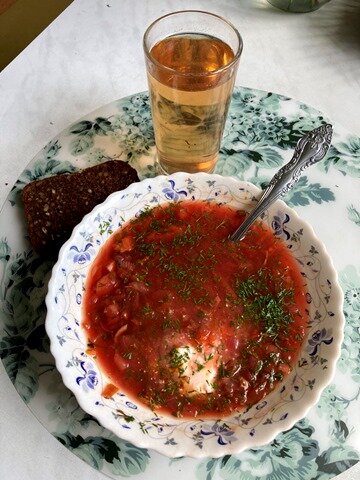Anya Stork’s Recipe for Russian Borscht
Anya Stork wrote a moving account of her life in Russia: Once Upon a Soviet Child: Piano, Potatoes, and Privations. This is the first of three volumes, available for order on her interesting website: AnyaStork.com. I had the honor of editing her book for her.
My ancestors came from Russia to the United States around 1918, and she came around 1990, but many of the things she describes resonated with me. I think readers from teenagers through babushkas (grandmothers) will enjoy her true stories about grocery shopping, visits to the dentist, folk cures for illness, the weariness of the competitiveness in all aspects of life, and the need for privacy as she became a teenager. And as Americans, we can feel a renewed sense that despite all the recent political turbulence, our system of education, government, and lifestyle certainly is far superior to what Anya endured. Sometimes, reading about another culture makes us realize our own is more valuable.
This is a good read. Buy it and enjoy it. Meanwhile, appreciate the borscht!
As we watch the snowfall here in Maryland, it feels right to have a borscht recipe to enjoy on a cold winter night.
The famous Russian Borscht Beet Soup (Vegetarian Version)
There’s a saying that every Russian woman makes borscht differently. It is true. Every region has its twist to this basic recipe. For example, I was surprised to find out that my Ukrainian friends even add beans and bell peppers to this soup!
My mom never did. Part of that was scarcity during Soviet times, and we lived up north, in Moscow, which was much different from living in the southern parts of Russia, such as in Ukraine.
For instance, my Ukrainian grandpa liked to add finely chopped pork fat, salo, to his borscht, along with many fresh garden vegetables that he grew. He chopped everything finely, even potatoes, in tiny cubes, while in Moscow, we cut potatoes in big chunks!
So, don’t be afraid to improvise and add your signature to this soup.
The traditional Russian borscht recipe calls for meat broth (usually a beef bone broth), but I like cooking my borscht vegetarian with just a vegetable broth.
The following is the basic borscht recipe. I cook it the way my mother taught me.
Ingredients
1 lb. beets (beetroot), or a bunch
2 medium onions
2 large carrots
¾ lb. white cabbage
3-4 tablespoons vegetable oil (traditionally, sunflower oil)
5 vegetable cups of beef stock (or a beef bone, for most traditional recipe)
Potatoes (6-8 medium sized) - plenty of potatoes!
Salt, Black pepper, & garlic (to taste)
Bay leaf (optional, for garnish), 1-2 per large pot
Sour cream (optional, omit for vegan soup)
Directions:
Boil the beets (with the peel) until they are soft inside;
(it takes about 40 minutes, and it’s the longest part of the preparation, so I like doing it the day before; it’s much easier to grate beets when they are either cool or at room temperature, and cooling takes time! )Boil water in a large pot for the stock:
(if you are going to use the meat stock, boil the beef bone first), otherwise, you can go to the next step:Peel and cut potatoes; chop them in medium chunks and place in the pot with either cold or hot water, and bring to boil; meanwhile
Peel and cut the onions and carrots; carrots are traditionally grated on a medium-size grater, and onions can be chopped as desired -
Prepare a large skillet to sauté the onions and carrots. Onions will be sautéed first. When onions gain the golden color, add the carrots and continue sautéing them together;
Mom was mixing them frequently and also adding some water from time to time, not to let them dry up;
While onions and carrots are being sautéed, peel and grate the beets, on a medium-sized grater, not too finely;
Beets will go into the skillet next, with onions and carrots (beets are always sautéed last, as they are the softest); continue mixing and sautéing the vegetables on medium heat, for another 10- minutes or so;Taste the water in the pot and add salt as desired; the traditional Russian borscht has plenty of salt; you can add salt either directly to the pot with the boiling potatoes or the skillet with vegetables while sautéing them (that’s what my mom did);
Beets will be ready in about 10 minutes, and you can add the whole sautéed mixture from the skillet to the pot with the boiling potatoes;
(don’t hesitate to try a spoonful from the skillet! These veggies make a delicious side dish on their own)
Somewhere in the middle of cooking, mom would add the bay leaves to the pot for the aroma;
Usually, borscht will cook for about an hour, on medium heat. Once you added the sautéed vegetables, you can simmer it without a lid;
Prepare the cabbage. you can cut or shred it; my parents liked shredding the cabbage in long thin slices, not too finely (not like coleslaw!)
I like adding the cabbage in bigger chunks; cabbage cooks very fast, so I usually wait until the very end of cooking to add it, and in about 5 minutes, it’s ready;
Mom continued cooking/simmering borscht for at least 20 more minutes after adding the cabbage;Season to taste with salt and black pepper, if you wish); sometimes, mom would put in finely chopped garlic, too;
This is it! Garnish borscht with your favorite spices (black pepper, parsley, chives are some of the very traditional choices) and serve it hot.
Note:
the traditional Russian borscht is served with a piece of black bread and a spoonful of sour cream
Pri-yat-nogo ape-ti-tA! (Bon appetite!)

